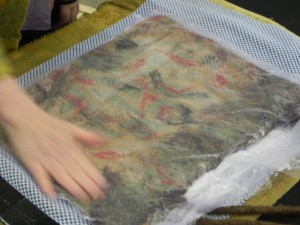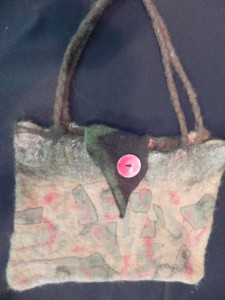If at first you don’t succeed…
Monday September 26, 2016

We all know the ending of that phrase is, "try, try again." Felt making is like that. There are infinite varieties of colors, textures, techniques, and processes out there. Some methods work better than others; some work for some of us but not for other people. Some work once but not twice. But, one of the reasons I love felt is that it is so variable. I love those happy surprises that happen when an edge is turned under with a tad more fiber in one place than another or the edge scoops in a bit more in one place than in another. I love that organic part of felting; however there is the side of the craft that needs consistency. When I set out for a certain look and don't get it, that sets up a problem for me to solve.

Of course, I don't set out to solve problems, I want to make beautiful things. Sometimes, however, something unexpected happens and the result is something other than it was planned in a not-so-good way. Problem-solving with felt is like any other type of problem-solving, the more experience you have, the more tools you have to draw on from your toolbox.
It also has to do with our personalities and how much we are willing to delve into the problem. I know sometimes I am of the "well, that didn't work" ilk and I move on to something else. In the back of my mind I know that's not the right approach and I need to practice the try, try again piece! The better you understand fiber and how/why it moves, the better you are able to assess exactly what caused the problem and correct it next time. I am a big believer if sampling; I sample all the time even if it is just a palm-sized sample. I also save all those samples and refer back to them.
I have nothing but admiration for the felt maker who can make a piece, identify what she does not like about it or see how she can improve it next time, and actually tries again with a different approach. I have a felting buddy who wanted to emulate a really light style of laminated scarf she'd seen. Being a try-try-again-type person she must have made two dozen attempts, each followed by thoughtful examination, before she finally hit on the solution. Admirable--really admirable.
There is too much Type A in me to think that would be remotely possible. Does that make me a bad felter--not really. Does it cramp my style and inhibit my personal growth--most certainly. One of the reasons I enjoy our monthly felting group so much is that we take turns teaching techniques and processes to one another and we talk through how things are made. We ask, what would have happened if...and we are better felt makers for that exercise in analysis.
Examination and thinking things through adds more tools in your felting toolbox. It makes problem-solving a lot easier next time around. So, stop, think, analyze, calculate, and re-think. It will make you a better felt maker.

